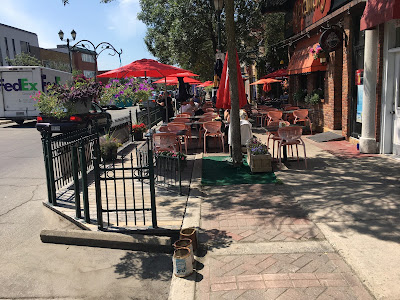 |
| Cafe terrace in downtown Montral |
A lot of what one imagines to happen on a "complete" street, namely walking, bicycling or outdoor seating seems implausible in a city so far north that half the year it is winter and where entire shopping streets are built underground to escape the harsh conditions.
 |
| US parklets on PARK-ing Day |
What a wonderful way to expand the pedestrian space not only for a day as in PARK-ing Day, an idea born in California and repeated annually across the US, but for the entire warm season. In Montreal, as in Baltimore, sidewalks are often too narrow to comfortably walk and have outdoor seating. The elevated wooden terraces solve the problem!
The arondissement Plateau has official policies for this. Since they went into effect in 2015 more than 1,000 new tables have been added on the streets of the Plateau-Mont-Royal; The rules are clear but also pretty simple: Materials have to be sturdy, the terrace has to be attractive and must be maintained by the owners, it can't be bigger than 50% of the original premise and can't have advertising, it is recommended to be enhanced by vegetation and it requires a permit. The terraces are only permitted in a certain district and only between April 15 and October 15. And, of course, there is a fee.
 |
| Cafe de terrace Rue St Dennis, Montreal |
The café-terrace is an open-air restaurant attached to an establishment that allows the use of a restaurant or an alcoholic beverage. This is a rental of public space by a private trader. The café-terrace is installed on the sidewalk and / or the roadway in front of a commercial establishment. The structure must be solid and equipped with a protective ramp, and the furniture (tables and chairs) must be removed or tied after closing at 11pm.There is also a "public option", it is covered with its own regulation and called a placotoir, presumably a composite of place (space) and trottoir (sidewalk).
the borough adopted a normative framework for the development of placotories on the public domain. The placotoir is an area of relaxation and meeting, open to all, laid out on the road in front of an establishment. It is a development of the public space, built on a platform, installed in continuity and at the same level as the sidewalk. All its elements must be attached to the structure (benches, bicycle racks or other). Sale and service are prohibited. There are no fees for occupying the public domain.(website)"Completing" a street with a sidewalk terrace is an idea that has caught on in outside Montreal as well. It should become a Baltimore staple. Just imagine a few of those in front of Tapas Teatro and Sofie's Crepe at the Charles, on Cross Street or on Hampden's Avenue! Via the already existing "minor privilege" arrangement, Baltimore could tap here into a revenue source while making its streets more complete and more pleasant at the same time.
Gude for sidewalk terraces
Klaus Philipsen, FAIA
Best Cafe Terrasses, Montreal
It was brought to my attention that BC-DOT has already a "public option" on the books, similar to Montreal's Placotoir. For details see here and here.
This is the first article in a series promoting innovative ideas from other cities for implementation in Baltimore.
 |
| Sidewalk expansion in La Chute, Quebec |

No comments:
Post a Comment